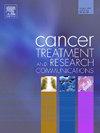Ferroptosis as the new approach to cancer therapy
IF 2.4
Q3 Medicine
引用次数: 0
Abstract
Cancer is characterized by unregulated cell proliferation, evasion of apoptosis, and a propensity for metastasis, making it a leading cause of morbidity and mortality globally. Major challenges in cancer treatment include drug resistance and tumor heterogeneity, which hinder the clinical efficacy of existing therapies. To enhance treatment outcomes, it is essential to integrate emerging biological insights and technological advancements with conventional therapeutic strategies. Recent research has identified various forms of cell death, which can be classified as either regulated or unregulated. Regulated cell death involves specific biochemical and signaling pathways, while unregulated cell death occurs passively and uncontrollably. Apoptosis, the most extensively studied form of regulated cell death, is primarily mediated by the activation of caspase proteases. Nevertheless, the resistance of many tumors to apoptotic pathways has shifted focus towards non-apoptotic forms of cell death, such as ferroptosis. Ferroptosis is an iron-dependent form of regulated necrosis characterized by extensive membrane damage resulting from lipid peroxidation. Numerous preclinical studies have demonstrated that inducing ferroptosis can significantly reduce tumor growth across a variety of cancer types. For instance, in a study involving breast cancer models, the use of ferroptosis inducers such as erastin and RSL3 led to a marked decrease in tumor volume and weight.
This review aims to explore the potential of ferroptosis as a novel therapeutic strategy in cancer treatment.
铁下垂作为癌症治疗的新途径
癌症的特点是不受调节的细胞增殖、逃避凋亡和转移倾向,使其成为全球发病率和死亡率的主要原因。癌症治疗面临的主要挑战包括耐药和肿瘤异质性,这阻碍了现有治疗方法的临床疗效。为了提高治疗效果,必须将新兴的生物学见解和技术进步与传统的治疗策略相结合。最近的研究已经确定了各种形式的细胞死亡,可分为受管制或不受管制。调节型细胞死亡涉及特定的生化和信号通路,而不调节型细胞死亡是被动和不受控制的。凋亡是研究最广泛的细胞死亡调控形式,主要由半胱天冬酶蛋白酶的激活介导。然而,许多肿瘤对凋亡途径的抗性已将焦点转移到非凋亡形式的细胞死亡,如铁下垂。铁下垂是一种铁依赖形式的调节坏死,其特征是由脂质过氧化引起的广泛膜损伤。大量临床前研究表明,诱导铁下垂可以显著减少多种癌症类型的肿瘤生长。例如,在一项涉及乳腺癌模型的研究中,使用erastin和RSL3等铁下垂诱导剂导致肿瘤体积和重量显著减少。本文旨在探讨铁下垂作为一种新的癌症治疗策略的潜力。
本文章由计算机程序翻译,如有差异,请以英文原文为准。
求助全文
约1分钟内获得全文
求助全文
来源期刊

Cancer treatment and research communications
Medicine-Oncology
CiteScore
4.30
自引率
0.00%
发文量
148
审稿时长
56 days
期刊介绍:
Cancer Treatment and Research Communications is an international peer-reviewed publication dedicated to providing comprehensive basic, translational, and clinical oncology research. The journal is devoted to articles on detection, diagnosis, prevention, policy, and treatment of cancer and provides a global forum for the nurturing and development of future generations of oncology scientists. Cancer Treatment and Research Communications publishes comprehensive reviews and original studies describing various aspects of basic through clinical research of all tumor types. The journal also accepts clinical studies in oncology, with an emphasis on prospective early phase clinical trials. Specific areas of interest include basic, translational, and clinical research and mechanistic approaches; cancer biology; molecular carcinogenesis; genetics and genomics; stem cell and developmental biology; immunology; molecular and cellular oncology; systems biology; drug sensitivity and resistance; gene and antisense therapy; pathology, markers, and prognostic indicators; chemoprevention strategies; multimodality therapy; cancer policy; and integration of various approaches. Our mission is to be the premier source of relevant information through promoting excellence in research and facilitating the timely translation of that science to health care and clinical practice.
 求助内容:
求助内容: 应助结果提醒方式:
应助结果提醒方式:


